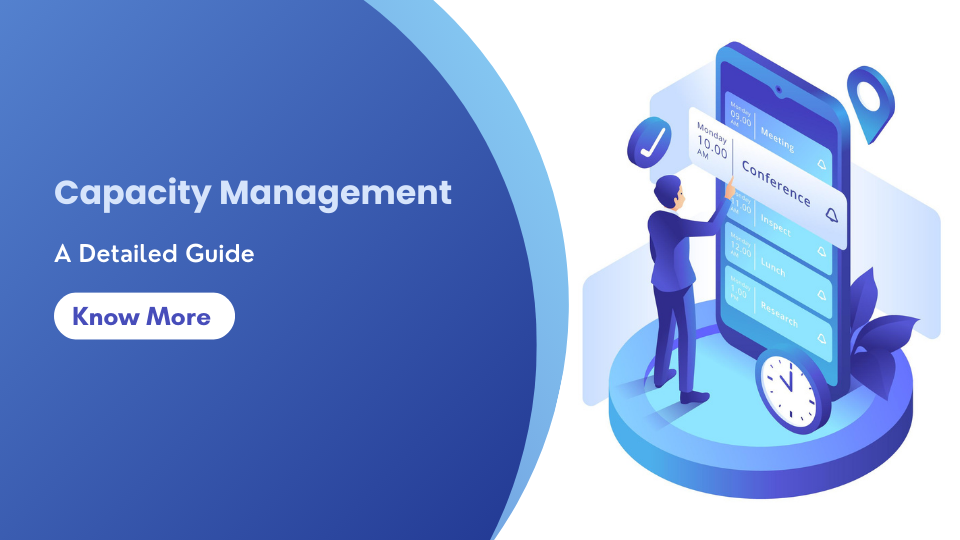
Charles Darwin’s theory of survival of the fittest is applicable to the business world. How? The volatile business and economic conditions only favor those businesses that have the ability to adapt.
One way to ride the tides successfully, consistently deliver projects and/or solutions, and maximize profitability is through proper capacity management.
Here’s our complete guide to capacity management. We explain its definition, the benefits it provides, and best practices of how to implement it correctly.
Capacity management is the process of ensuring that your firm’s resources are operating at ideal productivity levels in all scenarios and at all times. Simply put, with capacity planning your business will be able to meet all current and future project demands without having to hire new resources or overburdening existing ones. Capacity management is all about managing your resources optimally.
The goal of capacity management is to ensure that the costs stay under control and that all resources are functioning at the right levels of productivity.
If you don’t have sufficient resources, then you can’t deliver projects on time. You might end up making expensive last-minute hires.
On the other hand, if you have too many resources and not enough work, then you are burning through cash and cutting into profits.
Lastly, if you have unskilled staff, then your project might be delivered with lots of errors which will require you to rework the job for the same price tag.
Here’s an example of how capacity management works. Imagine you are running a design firm and you have two full-time designers that work 8 hours each. If there isn’t sufficient work for them, their salaries can become a redundant cost for the business. However, if there is too much work, then they can quickly become stressed and burned out.
The challenge is to have enough work to keep both working optimally throughout the day and changing market conditions.
You might be wondering what will happen if there are issues with your capacity planning. The costs of poor capacity management can be significant:
The key elements of capacity management are:
There are many advantages to performing capacity management. Your organization can benefit from the following if it focuses on capacity planning:
Through capacity management, you can ensure your resources are not only aligned to the right tasks but also have enough time to complete the jobs. This will improve overall productivity as resources are not over or under-utilized.
By ensuring that resources are used efficiently and effectively, organizations can reduce their costs. This can be done by avoiding overprovisioning of resources, which can lead to unnecessary costs. Through capacity planning, you won’t have to pay overtime to employees or make last-minute, expensive hires to fill resource gaps. You will also avoid paying for under-utilized employees.
With capacity planning, you can use historical data to forecast how many and which projects you can take. Through capacity planning, you have visibility on which resources are available, what they are working on, and how much time they have pending. Based on these metrics you can take on projects without the fear of not being able to deliver.
When resources are available at the right time of need, organizations can improve their project deliveries. Consistently delivering super solutions within the required timeframe and budget, will lead to enhanced customer satisfaction and company reputation. This is especially important for organizations that provide time-sensitive services or that have a high demand for their products or services.
Want to do capacity planning correctly? Here are some strategies to follow:
Capacity management is a cross-functional process that should involve all stakeholders, such as IT, finance, and operations. This will ensure that the plan takes into account the needs of all departments and that it is feasible to implement.
There are a number of software tools, such as resource management software, that can help with capacity management. These tools can automate many of the tasks involved in capacity management, such as demand forecasti ng, capacity assessment, and planning.
The demand for resources can change quickly, so it is important to be flexible with the capacity plan. This may mean making changes to the plan on a regular basis or having a contingency plan in place in case of unexpected changes in demand.
It is important to monitor the actual utilization of resources against the plan on a regular basis. This will help to identify any potential problems early on so that corrective action can be taken. Do remember that a capacity plan is not set in stone, regularly review it and make changes as needed.
By following these tips, your business can effectively manage its capacity and ensure that you have the resources you need to meet current and future needs.
We know that capacity management is crucial, but the manual capacity management process is time consuming and prone to errors. Investing in capacity planning or resource management software helps you manage your capacity more effectively. The software will automate many of the tasks involved in capacity planning, resulting in significant time and monetary savings.
eResource Scheduler (eRS) is a cloud-based resource allocation and capacity planning software that helps organizations optimize their resources and improve their project delivery timelines. eRS offers a variety of features, including demand forecasting, capacity assessment, capacity planning, and resource allocation.
Also read:
How resource management system boosts consulting services project management
Resource forecasting in project management - create the right plan
The best remote working tools for businesses (big & small)
Leadership vs. Management: what's the difference?
Staff efficiency tracking: why small businesses need to track this
Plan Smarter. Schedule Faster.
Join thousands already using eResource Scheduler to align teams, time, and tasks seamlessly.